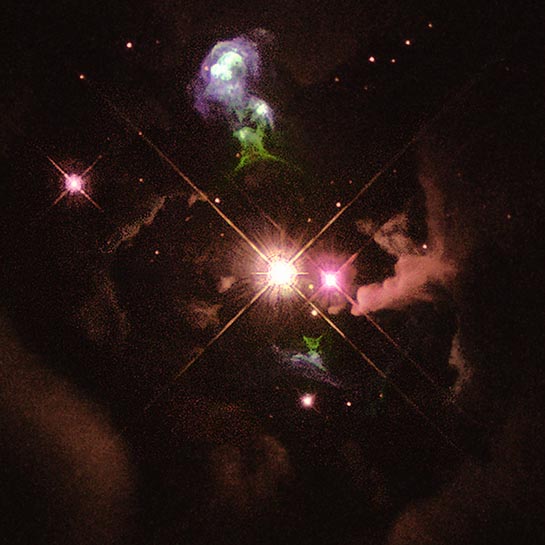
Ejected From a Young Star
Herbig-Haro Object
RA 19h 20m 33.13s Dec +11° 01' 20.09"
Aquila
300 pc (960 light-years) from Earth
17.5 (central star)
The image is 1.6 arcminutes on the vertical side. The end of the optical jet is 40" (~12,000 AU) from the central star. The total length of the bipolar outflow is about 0.17 parsecs or 0.54 light-years.
August 25, 1994
3.8 hours
North is toward the left of the image.
NASA & the Hubble Heritage Team (STScI/AURA)
October 7, 1999
ABOUT THIS IMAGE:
HH 32 is an excellent example of a "Herbig-Haro object," which is formed when young stars eject jets of material back into interstellar space. This object, about 1,000 light-years from Earth, is somewhat older than Hubble's variable nebula, and the wind from the bright central star has already cleared much of the dust out of the central region, thus exposing the star to direct view.
Many young stars, like the central object in HH 32, are surrounded by disks of gas and dust that form as additional material is attracted gravitationally from the surrounding nebula. Material in the disk gradually spirals in toward the star and eventually some of it accretes onto the star, increasing its mass. A fraction of the gas, however, is ejected perpendicularly to the disk at speeds near 200 miles per second, and forms two oppositely directed jets. These jets plow into the surrounding nebula, producing strong shock waves that heat the gas and cause it to glow in the light of hydrogen atoms (green) and sulfur ions (blue), several other atoms and ions, and sometimes radiation from the exciting star that is reflected by the surrounding gas (red).
This glow is called a Herbig-Haro object, in honor of astronomers George Herbig and Guillermo Haro, who did much of the early work in this area in the 1950's. The jet on the top side, whose furthest extent is about 0.2 light-year from the star, is pointed more nearly in our direction, while the opposite jet on the bottom lies on the far side of the star and is fainter either because it is partially obscured by dust surrounding the star or because there is much less material in front of the star.
The Hubble Heritage team (NASA/AURA/STScI) made this image from observations of Herbig-Haro 32 acquired by Salvador Curiel, Jorge Cant", Alejandro Raga, (UNAM), Alberto Noriega-Crespo (IPAC), and collaborators.
The image is a composite of black and white images taken through filters which isolate parts of the spectrum. Each image is assigned a color, then combined to produce the final image seen here.
The assigned filters are: Red: F675W (R), Green: F656N (H-alpha), Blue: F673N ([S II])
From Wikipedia:
Herbig-Haro objects (HH) are small patches of nebulosity associated with newly born stars, and are formed when narrow jets of gas ejected by young stars collide with clouds of gas and dust nearby at speeds of several hundred kilometers per second. Herbig-Haro objects are ubiquitous in star-forming regions, and several are often seen around a single star, aligned with its rotational axis.
HH objects are transient phenomena, lasting not more than a few thousand years. They can evolve visibly over quite short astronomical timescales as they move rapidly away from their parent star into the gas clouds of interstellar space (the interstellar medium or ISM). Hubble Space Telescope observations have revealed the complex evolution of HH objects over the period of a few years, as parts of the nebula fade while others brighten as they collide with clumpy material of the interstellar medium.
The
objects were first observed in the late 19th century by Sherburne Wesley
Burnham, but were not recognized as being a distinct type of emission
nebula until the 1940s. The first astronomers to study them in detail
were George Herbig and Guillermo Haro, after whom they have been named.
Herbig and Haro were working independently on studies of star formation
when they first analyzed the objects, and recognized that they were a
by-product of the star formation process.